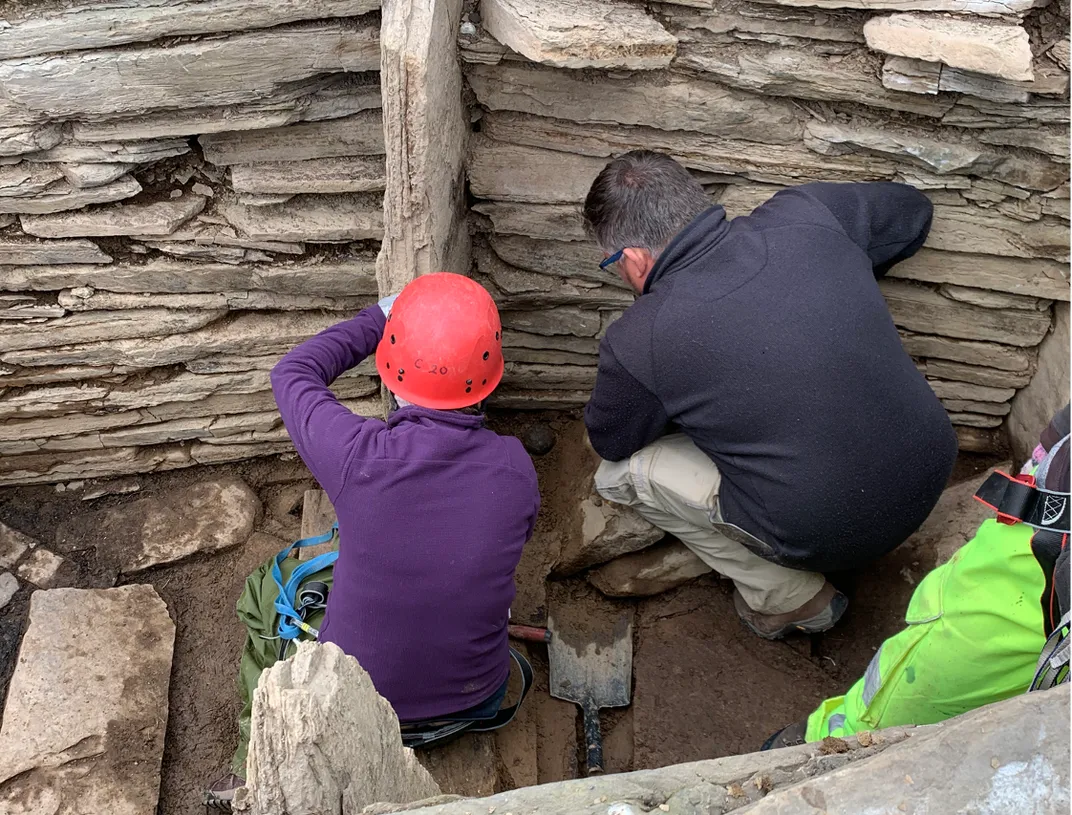Polished, 5,500-Year-Old Stone Balls Found in Neolithic Scottish Tomb
The rare artifacts were probably used as both weapons and symbols of power
:focal(530x412:531x413)/https://tf-cmsv2-smithsonianmag-media.s3.amazonaws.com/filer/2b/f8/2bf885ff-924d-4142-8698-b651ef68dad2/picture-ball1.png)
Archaeologists excavating a tomb at one of Scotland’s oldest known monuments have discovered two polished, 5,500-year-old stone balls, reports Alison Campsie for the Scotsman.
The team made the find at Tresness, a chambered cairn on the Orkney island of Sanday that dates to around 3500 B.C.E.
“A cracking find from the tomb!” wrote Hugo Anderson-Whymark, senior curator of prehistory at the National Museum of Scotland, on Twitter after the first ball’s discovery. “Only 20 or so Neolithic polished stone balls have been found in Orkney and few have been recovered from secure contexts.”
Anderson-Whymark later posted that the second ball was “the size of a cricket ball, perfectly spherical and beautifully finished. It’s split along bedding in the banded sandstone but will be amazing when conserved.”
Researchers have previously found plain stone balls at other sites in Orkney, including the Neolithic village of Skara Brae and the complex of buildings known as the Ness of Brodgar, reports the Press and Journal’s Ellie Milne. Archaeologists have also unearthed more than 500 carved stone balls, some in Orkney but most elsewhere.

Aberdeenshire, located on the Scottish mainland more than 100 miles south of Orkney, is particularly rich in these artifacts. One, known as the Towie ball, is carved into four knobs, three of which are decorated with intricate spiral patterns. Other examples found in the region feature distinctive patterns of spikes and ridges.
Researchers say the stones were probably used as both weapons and symbols of power. Remains of people of different ages and genders found in Orkney show signs of blunt force skull injuries possibly caused by such tools. But the discovery of polished balls in a burial is unusual.
The tomb at Tresness is split into several chambers. Vicki Cummings, an archaeologist at the University of Central Lancaster, tells the Scotsman that the tomb was probably connected to a Neolithic settlement at Cata Sand, about a mile and a half away.
“We have got the tomb and the settlement where people are living and they are more or less contemporary, so it seems very likely that the people building this monument were the people living at the settlement at Cata Sands,” she says.
Cummings adds that the landscape of the area was very different during the Neolithic period. Sea levels were lower, meaning the coast was farther from the tomb and the settlement, and the area was covered in trees.
Archaeological sites on the Scottish archipelago form a Unesco World Heritage site known as the Heart of Neolithic Orkney. Monuments, residential areas and artifacts found in the area testify to the farming practices of people who lived in northwest Europe before 4000 B.C.E.
In addition to the balls, notes the team on its blog, excavation of the cairn has uncovered fragments of pottery, knives and the antler of a Roe deer. As Cummings writes in a blog post, this season’s dig revealed how Bronze Age people altered the monument, removing stones and adding a new outer wall made up of large stones brought in from elsewhere.
“The Bronze Age cairn would have been really impressive,” she writes.
Archaeologists first explored the tomb in the 1980s. In 2017, a new series of excavations began “with an added sense of urgency,” according to Gizmodo’s George Dvorsky. The site faces erosion and the collapse of the cliff where it stands, so researchers are attempting to document the site and collect as many artifacts as possible before it’s too late. They have created 3-D models of the cairn that highlight sections constructed during the Neolithic period and the Bronze Age.
“At the end of the day, sadly this is a site that is disappearing into the sea so we are extracting this information before it is basically lost forever,” Cummings tells the Scotsman.
/https://tf-cmsv2-smithsonianmag-media.s3.amazonaws.com/accounts/headshot/Livia_lg_thumbnail.png)
/https://tf-cmsv2-smithsonianmag-media.s3.amazonaws.com/accounts/headshot/Livia_lg_thumbnail.png)